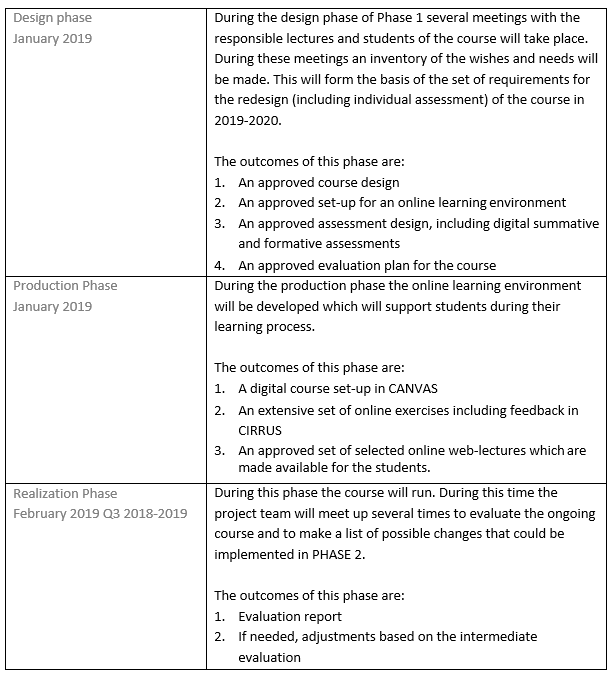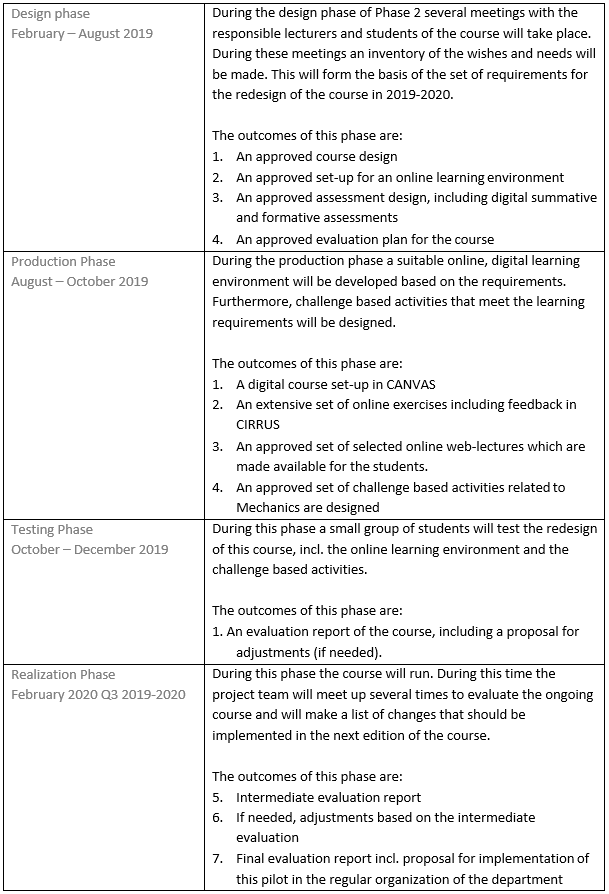Background and justification of the project
The course Mechanics (3AMX0) is the first, more in-depth course that first year Applied Physics students will follow. Whereas the first two quarters of the Applied Physics Bachelor program mainly focus on the repetition of High School content, this course focusses more on in-depth Applied Physics content.
The course Mechanics is a mandatory course of the Applied Physics bachelor education program. The course covers the basic principles of classical mechanics, based on Newton’s laws. The content includes the concepts of work, kinetic and potential energy, linear and angular momentum, torque, moment of inertia, central force fields with emphasis on the gravitational force, rotating non-inertial frames and fictitious forces, rotational motion of rigid bodies. In addition, an introduction to the special theory of relativity is presented. Based on the course survey in 2017-2018 students find the course quite difficult (4.1 out of 5). The students appreciated the set-up of the course and the selected course materials. In 2017-2018, the set-up of the course was the following. Each week, there was a lecture of two hours for the knowledge transfer. In addition to the lectures, four hours of Studio Classroom were given. Studio Classroom is a mix of self-study and lectures provided by the five lecturers of the course. Furthermore, during the course there were also weekly interim tests of one hour and one hour of feedback on these interim tests. Students appreciated the set-up of this course, however the students felt that the course was very time consuming. Also, the involved lecturers experienced the course as time consuming and intensive. What the students did like about the set-up of the course were the Studio Classroom sessions as addition to the lectures, because the interaction with the lecturer was very helpful. Studio Classroom gave the students the possibility to apply the theoretical concepts they learned during the lectures. However, according to the students four hours of Studio Classroom is too much, they lose their focus and concentration. Furthermore, according to them there could also be the possibility to do the exercises and study the materials in another way then in a classroom setting, for example using an online setting and weblectures.
More than that is currently the case, the future students of the course Mechanics will be a group of learners of more diverse backgrounds, with equally diverse motivations, learning styles and educational needs, in line with the comments made on the 2030 strategy vision of TU/e. Therefore the current set up of the course should enable students to have their personal learning path, to have ample of freedom of choice to pursue their own goals and interests, while meeting the requirements of the course. To enable students to follow their own learning paths within the course, digitization of the course is needed. Digitization makes learning independent of time and place, but also independent from learning style and educational needs. In order to support the personal learning paths of the students, the role of teachers will also change. Instead of focusing on knowledge transfer, teachers will be more focused on the facilitation of the learning processes. Being more of a content expert and coach/tutor in a small scale hand-on setting instead of a teacher in a large group setting. The teacher will determine the learning outcomes of the course, and the students will be responsible for determining its learning route through the course, taking into account that each student may have different needs in order to achieve the same learning outcomes.
Objectives and expected outcomes
The aim of this project is to develop a new set-up for the major course Mechanics that enables and supports students to follow their own learning path in such way that at the end of the course they master the required content. Taking this a step further, the responsible lecturer of this course wishes to be able to transfer required knowledge on Mechanics without giving mass, mandatory lectures in 2019-2020 but using open-ended, challenge based activities in combination with different forms of (digital) learning resources to transfer the required knowledge. In order to accomplish this following educational innovations are proposed. Within this project, two phases can be discriminated:
PHASE 1 is dealing with the first innovations towards a more student-centered, digitalized learning environment for the course in Q3 of 2018-2019, aiming at a further digitization of the existing course:
To make learning more independent of time and place a digitalized learning environment will be developed by a team of teaching assistants. In this learning environment students should be able to learn new concepts in a digitized learning environment. This learning environment will contain:
- A digital course set up in Canvas, with a clear structure of weekly learning outcomes, learning materials and exercises. Including well documented, step-by-step, explanations of the exercises through which students will learn a problem solving strategy.
- To make the exercises of the course available online by transferring them to CIRRUS. A special point of attention is that the student receive constructive feedback when they submitted their result.
- In addition to the current lectures, offer students the possibility to use weblectures as source of their learning content depending on the student’s individual learning style and needs.
For PHASE 2 of the educational innovation the goal is to transform the course Mechanics entirely to a course which enables students to design and follow their individual learning path, to a course with small-scale hands-on learning, to a course without any form of large-scale education like lectures. In this course the role of the teacher will be transformed from transferring the content to facilitating the learning process of the student. To accomplish this the course in 2018-2019 will be evaluated extensively. Based on this evaluation a course design for the course in 2019-2020 will be developed. A special point of attention in this course design will be the digitization of the course content, but in addition to this to design open-ended, challenge based activities which will result in a better integration of the acquired knowledge and skills.
Project design and management
The project goal is to design a course that enables students to follow their own learning path to master the required knowledge on Mechanics. In order to reach this goal the following project phases are proposed:
PHASE 1
For the course in Q3 of 2018-2019 a digital learning environment for the course content and exercises will be implemented.

PHASE 2
The goal for the course in Q3 of 2019-2020 is that the design of the course will support the students individual learning path, including small-scale, challenge based activities.

Dissemination and sustainability of the project
Within the TU/e the department Applied Physics is one of the precursors of hands-on, challenge based education. To share the experiences with this course potential users will be informed about this project through:
- Educational lunches / Education days, incl. the TU/e Innovation Day
- Meetings of the TU/e Program Directors
- Publications, for example related to AUTIQ (Advanced University Teaching Innovation Qualification
- (International) Conferences on education innovation, for example the ICAB conference.
Results and learnings
This project is still ongoing.
